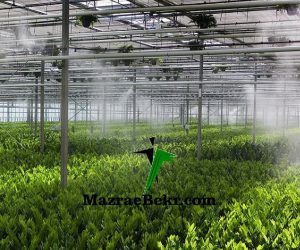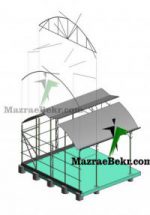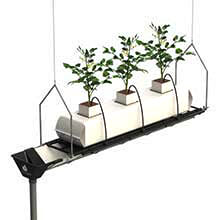Production of Dutch Rose Greenhouse Roses
Nowadays, creating employment, producing more and optimizing along with the productivity of resources, especially water, is very important. Production of cut flowers can become one of the profitable jobs by observing scientific and engineering laws in the construction of suitable greenhouses for cultivation and managing it with new methods. Roses have been remembered as queens of flowers since ancient times, but its medicinal uses were also considered at the time, but gradually its cultivation and work became common in gardens. Human interest in this flower led to its production in the greenhouse. Currently, roses are one of the most popular flowers in the world and have the highest production rate compared to other flowers. Roses due to its high use in religious celebrations and ceremonies can be a good choice for production along withprofitability.
in this way if you want to obtain more information you can study the essay of greenhouse cost

Botanical Specifications
Roses belong to the Golsorkhian family. These plants are distributed in most parts of the planet and vary in terms of growth and shape of plants and flower production. Flowers may be in the form of single inflorescences, gerzen clusters (panicols) or deyhim. Some wild species have 5 petals and lots of flags. The underlying ovary is located inside a fleshy fruit called Hip,which can change color by reaching from yellow to red.

Types of greenhouse rose cultivars
Rosacea genus has about 150 species that are scattered from cold northern regions to subtropical regions. Different types of roses are processed in terms of growth, plant shape to miniature, hybrid tea, floribanda, shrub, ballaru, which are more used in the production of greenhouse cut roses than hybrid tea and floribanda cultivars due to the production of endflower.
1- Hybrid teas have long stem roses and single coarse flowers at the end of eachstem.
2- Floribundas are the roses of this group of pronunciations of tea hybrids and polyantha verdes.
Today, most producers of greenhouse roses in the world use grafted varieties on resistant and suitable foundations, rosa manetti base in America andR. canina and R. indica bases are common in European countries.
Greenhouse structure suitable for breeding Dutch roses
The greenhouse structure is galvanized with pipes 5 and 6 that are connected by screws and screws. The height of the structure is between 5.5 and 9 meters, which in some areas with increasing the height of the greenhouse up to 8 meters, provides the possibility of increasing ventilation and carbon dioxide content, which is effective in yield and quality of the product. The foundations in the soil are inhibited by concrete, in creating bends should be careful. Gonia is very important for resisting strong winds. The greenhouse can be constructed in two units of 2500 meters or even a 5000-meter unit. However, the more greenhouse space, the more photosynthesis efficiency will be increased and the better quality of the greenhouse will beproduced.
Greenhouse coatings have different types such as polycarbonate, UV,secorite coatings, etc. They are affordable in terms of stamina and firmness of polycarbonate type, but because the costs are high at the beginning of the work and the greenhouse, it is cost-effective to use the UVcoating.
Among the equipment used in greenhouses equipped with flower farming are thefollowing:
Suitable heating, cooling and ventilation systems
Suitable substrate for cultivation
Climate Control System
Energy saving Curtain
Irrigation & Irrigation System
Refrigeration & Sorting System
Cultivation
Suitable greenhouse rose bed has the followingcharacteristics:
The substrate composition consists of 35% cocopeat, 65% perlite with suitabledrainage.
The cultivation distance is 15 to 20 cm and the corridor distance is 90 to 100cm.
The width of the substrate is 40 cm and its depth is 30 to 35cm.
The height of the cultivation platforms from the ground up to the edge of the bed is 80 to 90 cm and their length is 40cm.
Soil: Sandy clay, loamy or soil soils that have a little clay and have 10% suitable organic matter, sandy soil is not suitable for growth of this plant and also its growth in calcareous soils should be avoided.
The pH for this flower is about 6.5, but it likes a PH of 5.5 to 7.5.
The appropriate EC is less than 1.8, but the EC in closed hydroponic systems is 0.7.
Irrigation andhumidity: For optimal growth, they need enough moisture, this amount of moisture measured by moisture meter in greenhouses suitable for rose breeding is 50% per day and about 60% atnight.
Temperature: Overnight temperatures of about 16 °C are suitable for plant growth, temperatures of 20 to 21 °C on cloudy days and 24 to 28 degrees on sunny days are very suitable and the optimal difference between night and day temperature is 10-13 °C, in which case the flowers are ready to be harvested after about 40days.
Light: Rose plant needs light with high intensities, so the best greenhouse in terms of coating is glass greenhouses, in countries like the Netherlands sometimes due to a little intensity of light in winter, artificial lights are also used for some species, but in Iran due to abundant sunshine in most provinces there is no need to do this usually the amount of light in greenhouses suitable for the cultivation of this flower between 30 and 30. 3 5,000 lux varies.
Proliferation of greenhouse roses
The proliferation of roses is through cuttings and grafts. In order to prepare cuttings, maternal plants must be grown under appropriate conditions. Cuttings are prepared after the branches mature and the leaves reach the finalsize.
Maternal plants inside the greenhouse are growing permanently all year round, so leaf cuttings can be prepared all year round. Cuttings are harvested with one to three nodes and only the end leaves are kept and the lower leaves areremoved.
Cuttings are then placed inside the rooting bed, which is usually a mixture of sand, perlite and peat moss. Perlite is accessible and suitable with medium aggregation of rooting substrate. Temperatures between 21 and 25 °C in the substrate environment cause better rooting of cuttings.
In grafting, better growth and development of the scion and increasing growth strength, tolerance of soil acidity and salinity, tolerance of relative moisture of soil and environment, resistance to pests and diseases, increase in life and life of plants, adaptation to environmental conditions, resistance to winter cold is veryimportant.
Feeds
In the cultivation of roses at the time of planting, high fertilization should be avoided. Fertilizers are usually provided to plants in water soluble greenhouses. Nitrogen, potassium, magnesium and iron are regularly used in fertilizer solution, and micronutrients such as boron, copper, manganese, molybdenum are periodically added to fertilizer solution. Fertilizer ratio 195:30:220 ppm (N:P:K) is suitable for fertilization of greenhouse roses.
Drunning and caring
Usually, in rose greenhouses, the banding method is used, which is very useful for roses physiologically and preserves more leaves on the plant and helps to accumulate hormones in the buds at the end of flowering branches, and larger and stronger flowering branches are produced and yield can be increased up to 20%. In banding, branch removal and budting are performed. Bandings are carried out from one to 2 cm above a knot with strong buds and in contrast to the germ growthpopulation.
Annual care in rose greenhouses is in early spring, mid and late spring, early summer, mid-summer andautumn.
In early spring, in the form of soil modification, planting new bushes and foundations, doing spring pruning before the emergence of new leaves, eliminating all the sick, dry, wounded and broken branches, fertilizing around the plants by drip irrigation system, resuscitation of weak bushes with fertilization and pruning issuitable.
In the middle and late spring, in the form of controlling the broken sites of the plant and starting pest control, the continuation of planting of new bushes andfoundations.
In early summer, care is taken by controlling weeds and fertilising ifneeded.
In mid-summer, by removing dried flowers, fertilising, plant proliferation, controlling fungal diseases such as whites, black and yellow spots, pruning and branching heads, care is taken to remove the branches that haveflowered.
In autumn, by ordering new plants and preparing suitable substrate, they will create new cultivation or increase the cultivationlevel.
Important diseases of roses
Powdered whites are one of the most dangerous fungal diseases of cut roses in the greenhouse. The symptoms of the disease are seen as distinctive white spots on the young leaves and in severe condition the leaves are twisted and twisted in the form of snakes. High humidity and temperatures of 18-25 are the most suitable for the progression of the disease. Ways to fight the diseaseinclude:
- the use of resistant cultivars.
- Spraying liquid sulfur at temperatures below 30°C.
- The drunning of the infected branches at the end of theseason.
Black rose spots are seen as spots with a diameter of 2 to 12 mm on the top of the leaf, these spots are round and irregular first, and then the chlorosis is observed in the whole leaf. Small red spots may also be seen on petals. Since moisture in the greenhouse can be controlled, it can be prevented. So that the leaves are placed in high relative humidity more than 7-12 hours and irrigation on the surface of the plant should be avoided. In contaminated leaves, fungicide should be used every 10 to 15 days to remove the winter period causing thedisease.
Gray mold is a disease known as flower and bud burns and is more common in storage and transportation conditions of cut rose branches. The symptoms of the disease are that the flowers can no longer be opened and are covered with fungi that are brown or gray. Withered infected buds and grayish black spots may form at the base of the bud on the stem. The proper growth temperature of this fungal disease is 15°C and the wounding of the plant causes the fungus to attack the plant. In order to control this disease, the infected buds, flowers and stems can be collected and destroyed in the greenhouse after the symptoms of the disease.
Important pests of roses
Yellow aphid: This pest is seen in green, pink and reddish brown and feeds on plant beshes. Spraying with systemic pesticides is very effective in fighting thispest.
Two-point tick (spider web): This tick is seen in yellow to green and is considered one of the most important pests in the greenhouse. The leaves of the rose plant are attacked and yellowed and with the formation of many fibers by rounded ticks, it seems that this pest has many generations throughout the year and in two weeks a whole generation. In order to control the pest, ticks that do not cause leaf burning should beused.
Harvesting & Packaging
In each season, the way the flower is harvested changes. In winter, in order to achieve better light, it is harvested at higher altitudes and from the lower part in summer. At the time of harvesting, it should be noted that from the top of the node, the branch should be cut until after harvesting, the node grows and becomes the next flowerbranch.
Usually the distance between the nodes is 5-10 cm. In winter, a higher node is harvested relative to summer. Rose packing is based on branch size starting from 40 cm to 50-60-70-80-90-100 cm. usually all 20 rose branches are placed in a wrap.
The price of packages is determined according to its size. About two million rose branches are produced annually in this hall. Water Dip is a bold face with a muddy variety. Naomi Red Rose produces fewer flowers, the market like red rose is more and more usual, sometimes for the coloring of the rose, white flowers are placed in the bucket containing blue color, petals become blue and the red rose is placed in the bucket of blue color.
Mechanical damages, humidity and temperature stresses should be prevented at the time of flower harvesting. Reducing plant breathing and putting in cool air makes it refreshing and refreshing with flowers. Harvesting should be done in the afternoons due to carbohydrates. Roses after harvesting are very sensitive to ethylene gas and cause flower loss and flower aging and if exposed to ethine for 2 hours, it will bedamaged.
After rose harvesting, the following solutions are used to increase the shelf life and shelf life of goljay.
- Use of antiethylene materials such as thiosulfate and DMCPdimethyl silcopropane
- Prevent air in vascular tissues after harvest because it reduces its absorption by cutmud.
- The use of sucrose (sugar) in storage solutions isrecommended.
- Water pH is reduced to 3-4 using citric acid or aluminum sulfate, lemon juice, bleaching liquid to increase the life of the flower.
- Cutting the end of the stem is effective in increasing the life of theflower.
Export
The cut flowers business has become a profitable business. One of the most widely consumed cut flowers is the famous rose, which due to its high market popularity, is not a problem in marketing and selling it compared to other cut flowers. This flower has many varieties, each of which has a special beauty. The main producing countries of this flower are the Netherlands, Spain, USA, United Kingdom, Colombia, Ecuador, Kenya, South Africa, India, etc. he named it. Also, European countries, The United States, Central Asian countries and Japan are the main importers ofroses.
In Iran, rose production is mostly restricted in Tehran, Markazi, Isfahan and Khuzestan provinces. In mountainous provinces of Iran, due to the difference in elevation from sea level and the difference in temperature day and night, they have become one of the hubs of producing high-quality cutroses.
Roses in global markets have important and desirable traits in exports, among themthe following:
- It has a long and sturdy branch for sturdymaintenance.
- Suitable size and color of flowers related to the desired cultistand.
- Simultaneous flowering and uniformity at harveststage.
- Flowers are free of paleness, burns, pests anddiseases.
- The size of the branches is thesame.
- Freshness and transportation of flowers to the destinationmarket.









